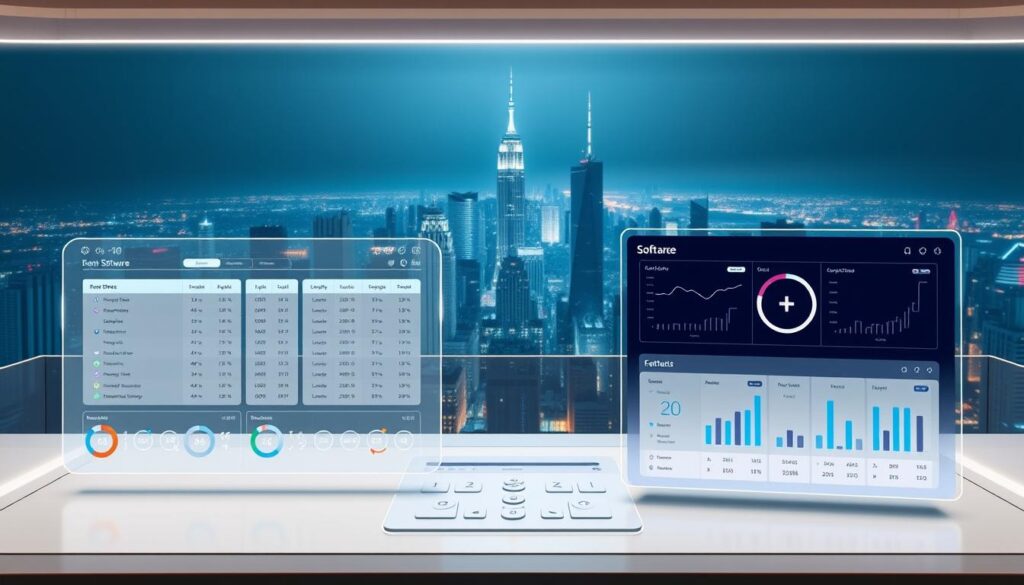The year 2025 is poised to revolutionize the way businesses evaluate and select software solutions, driven by advancements in AI, machine learning, and data analysis.
With the increasing complexity of technology, companies are faced with the daunting task of choosing the right tools for their operations. A recent study highlighted that nearly 70% of businesses struggle to find the optimal software that meets their specific needs.
This article aims to provide a comprehensive overview of the best software comparison tools available in 2025, helping businesses make informed decisions.
Table of Contents
Key Takeaways
- Top software comparison platforms for 2025
- Essential features to look for in software comparison tools
- Impact of AI on software evaluation processes
- Best practices for comparing software solutions
- Future trends in software comparison technology
The Evolution of Software Comparison Tools in 2025
As we step into 2025, software comparison tools are evolving at an unprecedented rate. The integration of advanced technologies is transforming how businesses evaluate and compare software solutions.

Key Advancements in Comparison Technology
One of the significant advancements in software comparison technology is the use of machine learning algorithms to analyze software features and user reviews. This enables businesses to make more informed decisions by providing a comprehensive view of the software’s capabilities and limitations.
The incorporation of natural language processing (NLP) is another key development. NLP allows software comparison tools to better understand user queries and provide more accurate results.
How AI Has Transformed Software Evaluation
Artificial intelligence (AI) has revolutionized software evaluation by enabling personalized recommendations based on a company’s specific needs. AI-powered tools can analyze a business’s existing software stack and suggest alternative solutions that better align with their goals.
AI has also automated the review analysis process, allowing businesses to quickly identify the most suitable software solutions. By analyzing user reviews and feedback, AI-powered tools can predict user needs and provide insights that help businesses make informed decisions.
Latest Trends in Software Analysis
The latest trends in software analysis include a focus on user experience and integration capabilities. Businesses are looking for software solutions that not only meet their functional needs but also provide a seamless user experience.
Another emerging trend is the assessment of return on investment (ROI). Businesses are increasingly looking for software comparison tools that can help them evaluate the ROI of different software solutions, enabling them to make more informed investment decisions.
Top Software Comparison 2025 Platforms
Several top software comparison platforms have emerged in 2025, offering comprehensive comparison capabilities. These platforms are crucial for businesses looking to make informed decisions about their software needs.
G2
G2 is renowned for its rigorous review process and detailed comparison reports. It has become a go-to platform for businesses seeking reliable software comparisons.
Features and Capabilities
G2’s features include advanced review filtering, detailed comparison charts, and verified user reviews. These capabilities enable businesses to assess software options comprehensively.
Pricing Structure
G2 offers a freemium model, with basic features available for free and premium features requiring a subscription. The pricing is competitive, making it accessible to businesses of various sizes.
Capterra
Capterra is known for its wide range of software categories and user-friendly comparison tools. It caters to diverse business needs, providing detailed software comparisons.
Features and Capabilities
Capterra’s features include personalized software recommendations, detailed vendor profiles, and user reviews. These features help businesses find the most suitable software solutions.
Pricing Structure
Capterra operates on a freemium model as well, with additional services available for businesses requiring more in-depth analysis and support.
TrustRadius
TrustRadius focuses on community-driven reviews and in-depth comparisons. It has established itself as a trusted source for software comparison.
Features and Capabilities
TrustRadius offers detailed review analysis, comparison tools, and verified user reviews. These features facilitate thorough software evaluations.
Pricing Structure
TrustRadius provides a range of pricing options, including a free version and premium subscriptions with additional features and support.
Software Advice
Software Advice is recognized for its expert guidance and tailored recommendations. It serves businesses looking for personalized software comparison services.
Features and Capabilities
Software Advice offers personalized consultation, detailed software comparisons, and expert recommendations. These capabilities ensure businesses receive relevant software solutions.
Pricing Structure
Software Advice operates on a consultation-based model, with pricing varying based on the scope and complexity of the software comparison needs.
As highlighted by a recent industry report, “The right software comparison platform can significantly impact a business’s ability to make informed software decisions.” These top platforms are setting new standards in software comparison, empowering businesses to choose the best software for their needs.
Essential Software Comparison Methods and Techniques
To navigate the complex software landscape, companies need to utilize robust comparison techniques. Effective software comparison involves a range of methods and techniques that help businesses make informed decisions.
Feature-Based Comparison Approaches
Feature-based comparison approaches allow businesses to evaluate software based on specific functionalities and requirements. This method involves creating a detailed list of features required by the business and comparing how different software solutions meet these needs.
- Identify key features required by the business
- Compare software solutions based on these features
- Evaluate the presence and quality of each feature
User Experience Analysis
User experience analysis is critical for understanding how intuitive and user-friendly a software solution is. This involves assessing the interface, ease of use, and overall user satisfaction.
Key aspects to consider:
- Interface intuitiveness
- Ease of navigation and use
- User feedback and satisfaction
ROI and Value Assessment
ROI and value assessment help businesses determine the financial viability of a software investment. This involves calculating the return on investment and comparing it with the costs associated with implementing and maintaining the software.
Important factors:
- Initial investment costs
- Ongoing maintenance and support costs
- Projected return on investment
Integration Capability Evaluation
Integration capability evaluation is also essential, as it assesses how seamlessly a software can be integrated into existing systems. This involves evaluating compatibility with current technology infrastructure and potential integration challenges.
Aspects to evaluate:
- Compatibility with existing systems
- Integration tools and APIs available
- Potential integration challenges and solutions
Industry-Specific Software Comparison Strategies
Different industries have unique requirements when it comes to software solutions, necessitating tailored comparison strategies. The one-size-fits-all approach often falls short in addressing the diverse needs of various sectors.
Enterprise Solutions
For enterprise solutions, the focus is on scalability, security, and integration with existing infrastructure. These large organizations require software that can handle complex operations and large volumes of data.
Cloud vs. On-Premise Considerations
One of the critical decisions for enterprises is whether to opt for cloud-based or on-premise solutions. Cloud solutions offer flexibility and scalability, while on-premise solutions provide more control over data security.
- Scalability and flexibility
- Security and compliance
- Integration with existing systems
- Total Cost of Ownership (TCO)
Small Business Software Evaluation
Small businesses, on the other hand, prioritize ease of use, rapid deployment, and budget-friendly options. They need software that can grow with their business without requiring extensive IT support.
Budget-Friendly Options
When evaluating software, small businesses should consider the following factors:
- Ease of implementation and use
- Cost-effectiveness
- Customer support and training
- Scalability
Specialized Industry Tools
Certain industries require specialized tools that cater to their unique needs. For instance, healthcare software must comply with HIPAA regulations, while financial software needs to adhere to strict financial regulations.
Vertical-Specific Comparison Factors
When comparing specialized industry tools, consider the following:
- Compliance with industry regulations
- Specific features tailored to the industry
- Integration with other industry-specific tools
- User adoption and training requirements
By adopting industry-specific software comparison strategies, businesses can make informed decisions that meet their unique needs and drive success.
Conclusion
The software comparison landscape in2025 has evolved significantly, driven by advancements in technology and the emergence of various comparison platforms. As businesses navigate this complex environment, leveraging the right software comparison tools and methodologies is crucial for making informed decisions.
Staying updated on the latest software comparison trends enables organizations to optimize their software portfolios and drive business success. The integration of AI and other cutting-edge technologies has transformed software evaluation, allowing for more precise and efficient comparisons.
By adopting industry-specific software comparison strategies and utilizing top comparison platforms like G2, Capterra, and TrustRadius, businesses can ensure they are using the most effective software solutions. As the software comparison landscape continues to evolve, it is essential to remain informed about software comparison2025 developments to stay ahead.





